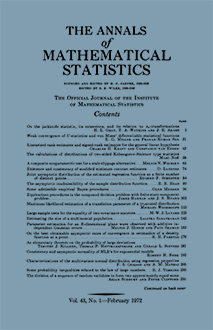Abstract
In [3], a general model for the reliability analysis of systems under various preventive maintenance policies is postulated and analyzed. The integral equations that determine the expected number of failures, the expected number of preventive removals, and the survival probability function are developed. In the present paper, a particular model of a system subject to marginal testing is considered and explicit values of these performance measures are obtained. Under a marginal testing policy, the system is maintained in operating condition by replacing all failed components as soon as they fail and, at regular intervals, conducting a test to locate those components which are still operating satisfactorily but which are expected to fail in the near future. All components located by this test are replaced. In this model, it is assumed that a component may be in any one of $n + 1$ states, $0, 1, \cdots, n$, and, during normal operation, these states constitute a continuous-parameter Markov process in which state $n$ is the failed state. When a component enters state $n$, it is immediately replaced by one in state 0. The marginal test detects the state and states $k, k + 1, \cdots, n - 1$ are considered marginal. The test is performed at fixed intervals, and, if a component is found in the marginal state, it is replaced by one in state 0. Since this model provides for transitions from any operative state to any other state, recovery from the marginal state to the good state is permitted, a characteristic which was not allowed in the model of [3]. In addition, a choice of the level at which the component is considered marginal is permitted. The loss of generality lies in the assumption that the process is Markovian. As in [3], it is assumed that there is no dependence between transitions in different component positions and that every system failure is corrected by the replacement of one component, so that the problem of determining system performance measures is reduced to the problem of determining the corresponding quantities for a single component position. In the analysis of this model, we shall first analyze the Markov process in the absence of marginal tests and determine the matrix of probabilities $H_{ij}(t)$ that a component is in state $j$ at $t$ given that it is in state $i$ at 0, the distribution function $F_i(t)$ of time to failure for a component initially in state $i$, and $\mathscr{B}_i(t)$, the expected number of failures in a component position by $t$, given that the component is in state $i$ at 0. It is then seen that, with the marginal test performed at intervals of length $T$ and replacement of marginal components, the states of the component just before successive test points constitute a discrete-parameter Markov chain. The matrix of transition probabilities $p_{ij}$ for this chain and the probability $P_i(r)$ that the component is found in state $i$ at the $r$th test point are determined. Then the expected number of preventive removals in a component position, $U_p(t)$, may be expressed as the sum of the probabilities of finding the component marginal over all test points before $t$ while the expected number of failures, $U_f(t)$, is expressible in terms of the $P_r's$ and the $\mathscr{B}_i's$. The asymptotic values of $U_p(t)$ and $U_f(t)$ are determined by the stationary properties of Markov chains. Finally, the Markovian nature of this model makes it relatively easy to express $R(t; x)$, the probability of no failure in a component position in an interval $t$ following system age $x$, in terms of the matrices discussed previously.
Citation
Betty J. Flehinger. "A Markovian Model for the Analysis of the Effects of Marginal Testing on System Reliability." Ann. Math. Statist. 33 (2) 754 - 766, June, 1962. https://doi.org/10.1214/aoms/1177704595
Information





